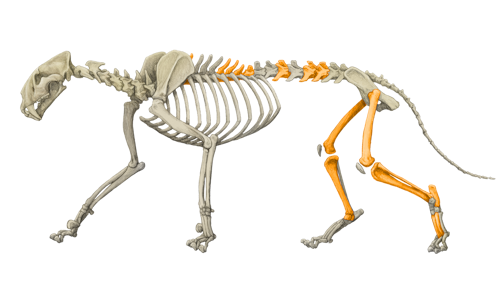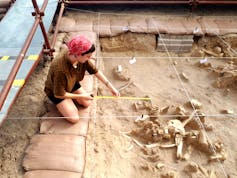
Over five million years ago, before our ancestors dominated the landscape, southern Africa’s west coast was home to a diverse array of prehistoric beasts. Among them were hyenas, small felines, giant civets, small mongooses, rhinoceroses and hippopotamuses.
Today, just 120km north of Cape Town, the Langebaanweg fossil area offers a window into this rich natural history. Various finds from Langebaanweg have allowed researchers to piece together what the region looked like during the Mio-Pliocene about 5.2 million years ago.
Our new research adds another piece to that picture: a large sabretooth cat whose long, curved canines made it a powerful predator. It was already known that several genera of sabretooth cat roamed the area around Langebaanweg – now we can add another, previously undescribed species.
This new research not only refines our knowledge about the sabretooth cats that lived and hunted at Langebaanweg. An abnormality we identified in the bones may also shed further light on the big cats’ hunting behaviour.
These findings are important because knowing where and when extinct species lived, and what other organisms they interacted with at the time, helps to build an ever-clearer picture of past ecosystems. Understanding the changing biodiversity of past ecosystems helps scientists to study long-term patterns of ecosystem development and species evolution. This, in turn, can help with predictive modelling to respond to the current climatic shifts and ecosystem collapses being seen around the world.
A new species?
The Langebaanweg fossil locality was discovered when phosphate miners broke ground in the 1950s. Continuous excavation efforts between 1960 and the late 1980s, spearheaded by palaeontologist Brett Hendey from the Iziko South African Museum, yielded a vast array of fossils. Many of them have yet to be thoroughly studied and are held in the Iziko Museum’s collections.

It was there, in 2020, that palaeobiologist Alberto Valenciano uncovered a peculiar set of large bones. They differed in size and shape from the bones of other carnivores from Langebaanweg like large primitive hyaenids or the African bear. He concluded that the bones probably belonged to a sabretooth felid.
At least three genera of sabretooth cats – Metailurus, Amphimachairodus and Dinofelis – were already known from Langebaanweg.
Working with palaeobiologist Anusuya Chinsamy-Turan at the University of Cape Town, we set about uncovering which genus is represented by the large bones from Iziko. This involved detailing the anatomy of the bones, taking numerous measurements and comparing these to those of other sabretooth cats from around the world, as well as similar extant species like the African lion.
Our results suggest the bones belong to a species of sabretooth that’s similar to two previously described sabretooths: Lokotunjailurus from Kenya, and Machairodus from Spain. More work will need to be done to confirm its exact classification. But this is made difficult because we haven’t found the animal’s teeth, which are often the most useful feature in identifying extinct species.
There’s another interesting element to our findings: we think the animal whose bones we studied had osteoarthritis.
An achy animal
While studying the fossilised bones we noticed deformities. Certain areas of bone were eroded; there were abnormal body growths on others. Some articular surfaces – the part of the bone where two joints meet – showed deep grooves. This indicates that cartilage had worn away until the bones scraped together.
All together, these deformities suggest the animal had osteoarthritis, a degenerative disease that we are familiar with in modern animals and humans.
Damage to the bones was particularly bad in the hind foot and lower back. The severity of the disease suggests that this sabretooth cat was an old individual who likely suffered with arthritis for some time. Drawing on veterinary work, and other research on palaeopathologies, we suggest that the animal would have experienced pain and limited mobility in the hindlimbs.
This has interesting behavioural implications. There is much debate about whether sabretooths were lone animals or stalked across the plains in prides like lions. This research adds to a growing body of evidence indicating that some sabretooths may, like lions, have relied on a social group when their hunting ability was impaired. Alternatively, if the Langebaanweg sabretooth was a lone animal, it may have dealt with its aching back and feet by resorting to scavenging rather than hunting.
Our diagnosis underscores the value of studying fossil bones. Doing so can lead to ecological and behavioural discoveries that help to construct a comprehensive understanding of a prehistoric animal.
Caitlin Bianca Rabe receives funding from GENUS through the South African National Research Foundation (NRF) and the Oppenheimer Memorial Trust.
Alberto Valenciano Vaquero received/recives funding from (GENUS (COE2018-09POST and COE2019-PD07), the R+D+I project PID2020-116220GB-I00, funded by the Agencia Estatal de Investigación of the Spanish Ministry of Science and Innovation (MCIN/AEI/10.13039/501100011033/), the Spanish Ministry of Economy and Competitiveness and FEDER funds (Research Projects PGC2018-094122-B-100), the Spanish Ministry of Science, Innovation, and Universities (‘Juan de la Cierva Formación’, ref. FJC2018-036669-I for AV), E33_20R (Gobierno de Aragón), and the Research Group UCM 910607).
This article was originally published on The Conversation. Read the original article.







